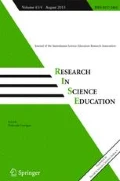Conclusion
This study had indicated that further research needs to be done into the examination of how subsequent learning will interact with knowledge previously gained. Does the learning of new knowledge in relation to previously understood knowledge cause interference (Biggs & Telfer 1986) or does it result in some confusion culminating in lack of linkages (Osborne & Freyberg, 1985)? Can the benefits of constructivism be built upon when using other strategies? These are some of the questions which arise from the results obtained in this study. This study does not provide any definitive solution to the questions; however it does show that long term retention of concepts learnt using a constructivist strategy does occur.
Similar content being viewed by others
References
BIGGS, J.B. & TELFER, R. (1986).The Process of Learning. Sydney: Prentice Hall of Australia.
DRIVER, R. & OLDMAN, V. (1985)A Constructivist Approach to Curriculum Development in Science. Paper prepared for the symposium “Personal Construction of Meaning in Educational Settings”, BERA, Sheffield.
HAND, B. (1988a). Is conception conflict a viable teaching strategy?: the students' viewpoint.Australian Science Teachers Journal, 34 (4) 22–26.
HAND, B. (1988b)Acids and Bases: Can Conceptual Conflict Change Misconceptions? Unpublished masters thesis. Perth: Curtin University.
HAND, B. & TREAGUST, D. (1988). Application of a conceptual conflict strategy to enhance learning of acids and bases.Research in Science Education, 18, 53–63. Sydney: Australia.
MINSTRELL, J. (1984) Teaching for the development of understanding of ideas: forces on moving objects. In Anderson, C.W. (Ed.)Observing Science Classrooms: Observing Science Perspectives from Research and Practice. ERIC Ohio State University Columbus, Ohio.
NOVAK, J.D. (1987)Proceedings of the Second International Seminar on Misconceptions and Educational Strategies in Science and Mathematics. Ithaca, Cornell University.
OSBORNE, R. & FREYBERG, P. (1985)Learning in Science: The Implications of Children's Science. Sydney, Heinemann.
PINES, A.L., and WEST, L.H.T. (1986) Conceptual understanding and science learning: an interpretation of research within a source-of-knowledge framework.Science Education, 70, 583–604.
Rights and permissions
About this article
Cite this article
Hand, B. Student understandings of acids and bases: A two year study. Research in Science Education 19, 133–144 (1989). https://doi.org/10.1007/BF02356853
Issue Date:
DOI: https://doi.org/10.1007/BF02356853




